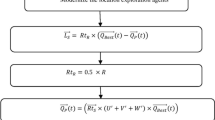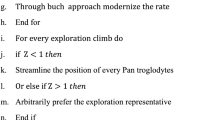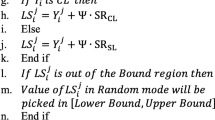Abstract
In this paper Extreme Learning Machine based Panthera leo Optimization Algorithm (ELMPO), Chaotic based Jungle search optimization (CJSO) algorithm and Quantum based Chipmunk Search (QCS) Optimization algorithm are applied to solve the power loss lessening problem. Extreme learning machine (ELM) is applied and learning speed of feed-forward neural networks is composed of input, hidden and output layer. Regular performances of Panthera leo are imitated to model the Panthera leo Optimization (PO) Algorithm. Panthera leo certainly lives as cluster. Panthera leos act as Executioners to quest the Victim. Full-fledged male Panthera leo will bout with other males to attain the room of dominance. The beaten Panthera leo will be as Refugee Panthera leo. Principally several times there will be modification between inhabitant and refugee Panthera leos. Together male and female Panthera leo shifts their places with orientation to the environments. In the preliminary population dominance and Refugee sorting are completed. For every Panthera leo fitness rate will be calculated. In Panthera leo population poise in conclusion of iterations, the quantity of prevailing Panthera leo will be meticulous. With orientation to the extreme permitted number of every gender in \(\mathrm{Refugee Panthera leo}\); the minimum sum fitness rate obsessed by \(\mathrm{Refugee Panthera leo}\) will be impassive. Extreme Learning Machine (ELM) is integrated with Panthera leo Optimization (PO) Algorithm and it entitled as ELMPO. Jungle search optimization algorithm is modelled based on the systematized performance of search squads viewing for lost entities in a jungle. Rendering to Jungle search optimization algorithm, as squads each comprising numerous professionals in the pursuit arena banquet out transversely in the jungle and progressively progress in the identical route by discovering the traces from the mark up until they discover the lost entity. This search organization is modelled in a scientific method in the arrangement of Inter-cooperative pursuit operatives and transporting the skilful associate to the first of the squad. Double procedures are smeared to shape the squads to do active search processes in all jungles and highland zones. The primary procedure is a local examination done by every squad; the leader of every squad assigns zones to every associate and provides them the accountability of examining that portion. The leader is informed of any trace discovered by squad associates and they will direct extra squad associate to that zone for additional effective examination to expand the search. Consequently, all squad associates effort to conduct an active search in the zones allotted to them. In the subsequent procedure, the squad that discovers maximum traces is obligatory by other squads. In detail, leaders of squads direct one of their squad associates to the squad with the maximum traces for assisting and do an active search in the jungles and highland. In the interim, certain associates continue in the squads that discover the minimum traces in order to endure the examination in the jungles and highland in the circumstances of any error made by the upper squad. Quantum based Chipmunk Search (QCS) Optimization Algorithm is based on the deeds of chipmunk and Quantum mechanism has been incorporated in the algorithm. Chipmunk spirited searching scheme and sashaying along procedure are simulated systematically to model the algorithm. When Chipmunk instigates the searching then examining procedure activates. In the segment of autumn period Chipmunk pursue for nutrition resources by sashaying in various trees and they alter the locations and regulate dissimilar area of the tropical forest. Quantum mechanism has been incorporated in the procedure.Through incorporation Quantum computing, algorithm performance has been advanced. Repositioning of Chipmunk at the conclusion of wintertime season is hypothesized. Gene collection, both breadth reductions in addition to upholding the accurateness of the designated genes is significant. As a replacement for of working for a repositioning of Chipmunk, the quantity of genes is abridged by in view of all the genes in the amalgamation of the trees in jungle; uppermost three Chipmunks is considered in the work. Subsequently to decrease, the Chipmunk is allocated haphazard locations in the abridged exploration zone. The wintertime is taken as to conclude when all trees in jungles possess fitness value superior than vibrant bound factor. Proposed Extreme Learning Machine based Panthera leo Optimization Algorithm (ELMPO), Chaotic based Jungle search optimization (CJSO) algorithm and Quantum based Chipmunk Search (QCS) Optimization algorithm are corroborated in IEEE 30, 57, 118, 300 and 354 bus test systems. True power loss lessening, power divergence curtailing, and power constancy augmentation has been achieved.
















Similar content being viewed by others
Data Availability
No data available.
References
Ahmadnia S, Tafehi E, Dastgahian F (2019) Optimal placement and sizing for solar farm with economic evaluation, power line loss and energy consumption reduction. IETE J Res. https://doi.org/10.1080/03772063.2019.1694450
Ashpazi MA, Mohammadi-ivatloo B, Zare K, Abapour M (2015) Probabilistic allocation of thyristor-controlled phase shifting transformer for transient stability enhancement of electric power system. IETE J Res 61:1–10. https://doi.org/10.1080/03772063.2015.1023743
Bentouati B, Khelifi A, Shaheen AM et al (2021) An enhanced moth-swarm algorithm for efficient energy management based multi dimensions OPF problem. J Ambient Intell Human Comput 12:9499–9519. https://doi.org/10.1007/s12652-020-02692-7
Bingane C, Anjos MF, Le Digabel S (2019) Tight-and-cheap conic relaxation for the optimal reactive power dispatch problem. IEEE Trans Power Syst 34(6):4684–4693
Bouwmeester D, Zeilinger A (2000) The physics of quantum information. Springer, Berlin
Illinois Center for a Smarter Electric Grid (ICSEG). Available online: https://icseg.iti.illinois.edu/ieee-30-bussystem/ (accessed on 25 February 2019).
Chen G, Liu L (2016) YanyanGuo, Shanwai Huang, Multi-objective enhanced PSO algorithm for optimizing power losses and voltage deviation in power systems. COMPEL: Int J Comput Math Electr Electronic Eng 35(1):350–372
Choi V (2018) Minor-embedding in adiabatic quantum computation: I. The parameter setting problem. Quantum Inf Process 7:193–209
Dai C, Chen W, Zhu Y, Zhang X (2009) Seeker optimization algorithm for optimal reactive power dispatch. IEEE t Power Syst 24(3):1218–1231
Darvish Falehi A (2020) Optimal robust disturbance observer based sliding mode controller using multi-objective grasshopper optimization algorithm to enhance power system stability. J Ambient Intell Human Comput 11:5045–5063. https://doi.org/10.1007/s12652-020-01811-8
Davoodi E, Babaei E, Mohammadi-Ivatloo B, Rasouli M (2019) A novel fast semidefinite programming-based approach for optimal reactive power dispatch. IEEE Trans Industr Inf 16(1):288–298
Diab H, Abdelsalam M, Abdelbary A (2021) A multi-objective optimal power flow control of electrical transmission networks using intelligent meta-heuristic optimization techniques. Sustainability 13:4979
Duong TL, Duong MQ, Phan VD, Nguyen TT (2020) Optimal reactive power flow for large-scale power systems using an effective metaheuristic algorithm. Hindawi J Electr Comput Eng. https://doi.org/10.1155/2020/6382507
Ebeed M, Alhejji A, Kamel S, Jurado F (2020) Solving the optimal reactive power dispatch using marine predators algorithm considering the uncertainties in load and wind-solar generation systems. Energies 13(17):1–19
Edalatpanah SA (2020) Systems of neutrosophic linear equations. Neutrosophic Sets Syst 33:92–104
Grudinin N (1998) Reactive power optimization using successive quadratic programming method. IEEE Trans Power System 13(4):1219–1225. https://doi.org/10.1109/59.736232
Hakli H, Uguz H (2014) A novel particle swarm optimization algorithm with Levy flight. Appl Soft Comput 23(1):333–345
Hussain AN, Abdullah AA, Neda OM (2018) Modified particle swarm optimization for solution of reactive power dispatch. Res J Appl Sci Eng Technol 15(8):316–327
Jan R-M, Chen N (1995) Application of the fast Newton-Raphson economic dispatch and reactive power/voltage dispatch by sensitivity factors to optimal power flow. IEEE Trans Energy Convers 10(2):293–301
Juneja K (2020) A fuzzy-controlled differential evolution integrated static synchronous series compensator to enhance power system stability. IETE J Res. https://doi.org/10.1080/03772063.2020.1795936
Karthik N, Parvathy AK, Arul R (2020) Multi-objective optimal reactive power dispatch using levy interior search algorithm. Int J Electr Eng Inf 12:547–570
Kazmi SA, Shahzad M, Shin D (2017) Voltage stability index for distribution network connected in loop configuration. IETE J Res 63:1–13. https://doi.org/10.1080/03772063.2016.1257376
Khazali H, Kalantar M (2011a) Optimal reactive power dispatch based on harmony search algorithm. Int J Electr Power Energy Syst 33(3):684–692
Khazali AH, Kalantar M (2011b) Optimal reactive power dispatch based on harmony search algorithm. Int J Electr Power Energy Syst 33:684–692
Khunkitti S, Siritaratiwat A, Premrudeepreechacharn S (2021) Multi-objective optimal power flow problems based on slime mould algorithm. Sustainability 13:7448. https://doi.org/10.3390/su13137448
Kien LC, Hien CT, Nguyen TT (2021) Optimal reactive power generation for transmission power systems considering discrete values of capacitors and tap changers. Appl Sci 11(12):5378. https://doi.org/10.3390/app11125378
Lakshmi Priya J, Jaya Christa ST (2021) An effective hybridized GWO-BSA for resolving optimal power flow problem with the inclusion of unified power flow controller. IETE J Res. https://doi.org/10.1080/03772063.2021.1942245
Lin JH, Chou CW, Yang CH, Tsai HL (2012) ‘chaotic Lévy flight bat algorithm for parameter estimation in nonlinear dynamic biological systems.’ J Comput Inf Technol 2(2):56–63
Liu X and Liu X (2013) Quantum-inspired genetic algorithm based on phase encoding. In: 2013 Ninth international conference on natural computation (ICNC), pp 444-448, doi: https://doi.org/10.1109/ICNC.2013.6818017
Luo S (2008) Quantum discord for two-qubit systems. Phys Rev A 77:042303
Lv F, Han M (2019) Hyperspectral image classification based on multiple reduced kernel extreme learning machine. Int J Mach Learn Cybern 10:3397–3405
Mandal B, Roy PK (2013) Optimal reactive power dispatch using quasi-oppositional teaching learning based optimization. Int J Electr Power Energy Syst 53:123–134
Mao X, Guoxi Z, Fallah M, Edalatpanah SA (2020) A Neutrosophic-based approach in data envelopment analysis with undesirable outputs. Math Probl Eng 2020:1–8. https://doi.org/10.1155/2020/7626102
Mei RNS, Sulaiman MH, Mustaffa Z, Daniyal H (2017) Optimal reactive power dispatch solution by loss minimization using moth-flame optimization technique. Appl Soft Comput 59:210–222
Menon P, Rani B, Kumar K, Gupta V (2021) An effective OS–DPLL design for reducing power dissipation in an IoT application. J Ambient Intell Humaniz Comput. https://doi.org/10.1007/s12652-021-03016-z
Mouassa S (2018) TarekBouktir, Multi-objective ant lion optimization algorithm to solve large-scale multi-objective optimal reactive power dispatch problem. COMPEL: Int J Comput Math Electr Electron Eng 35(1):350–372
Mouassa S, Bouktir T, Salhi A (2017) Ant lion optimizer for solving optimal reactive power dispatch problem in power systems. Eng Sci Technol Int J 20(3):885–895
Najafi HS, Edalatpanah SA, Refahi Sheikhani AH (2014) Convergence analysis of modified iterative methods to solve linear systems. Mediterr J Math 11:1019–1032. https://doi.org/10.1007/s00009-014-0412-3
Nuaekaew K, Artrit P, Pholdee N, Bureerat S (2017) Optimal reactive power dispatch problem using a two-archive multi-objective grey wolf optimizer. Expert Syst Appl 87:79–89
Omelchenko IN, Lyakhovich DG, Aleksandrov AA, Vodchits AS, Kunkov NV (2020a) Development of a design algorithm for the logistics system of product distribution of the mechanical engineering enterprise. Herald Bauman Moscow State Technical University Series Mech Eng. https://doi.org/10.18698/0236-3941-2020-3-62-69
Omelchenko I, Zakharov M, Lyakhovich D, Vodchits A (2020b) organization of logistic systems of scientific productions: scientific research work of the master's student and evaluation of its results. https://doi.org/10.18334/9785912923258.252-256.
Omelchenko I, Lyakhovich D, Alexandrov A, Vodchits A, Sturua K (2020c) Problems and organizational and technical solutions of processing management problems of material and technical resources in a design-oriented organization. 10.18334 / 9785912923258.257–260.
Pandya S and Roy R (2015) Particle swarm optimization based optimal reactive power dispatch. In: Proceeding of the IEEE international conference on electrical, computer and communication technologies (ICECCT), pp 1–5.
Polprasert J, Ongsakul W, Dieu VN (2016) Optimal reactive power dispatch using improved pseudo-gradient search particle swarm optimization. Electric Power Compon Syst 44(5):518–532
PSTCA, Power Systems Test Case Archive, University of Washington, Available: http://www.ee.washington.edu/research/pstca/, 2016
Quintana VH, Santos-Nieto M (1989) Reactive-power dispatch by successive quadratic programming IEEE Trans. Energy Convers 4(3):425–435
Raghuwanshi BS, Shukla S (2019) Class imbalance learning using Under Bagging based kernelized extreme learning machine. Neurocomputing 329:172–187
Reddy SS (2014) Faster evolutionary algorithm based optimal power flow using incremental variables. Electr Power Energy Syst 54:198–210
Roan N, Coll S, Alonso M, Rubio J, López P, Andujar F, Le S, Vu M, Smarandache F (2020) The picture fuzzy distance measure in controlling network power consumption. J Fuzzy Ext Appl 1(3):139–158. https://doi.org/10.22105/jfea.2020.249183.1009
Sahli Z, Hamouda A, Bekrar A, Trentesaux D (2018) Reactive power dispatch optimization with voltage profile improvement using an efficient hybrid algorithm. Energies 11(8):1–21
Z. Sahli, A. Hamouda, A. Bekrar, and D. Trentesaux, “Hybrid PSO-tabu search for the optimal reactive power dispatch problem,” in Proceedings of the IECON 2014–40th Annual Conference of the IEEE Industrial Electronics Society, Dallas, TX, USA, November 2014.
Sambaiah KS, Jayabarathi T (2020) Optimal modeling and allocation of mixed wind and solar generation systems in electric distribution networks. IETE J Res. https://doi.org/10.1080/03772063.2020.1787876
Saravanan C, Anbalagan P (2021) Multi objective dragonfly algorithm for congestion management in deregulated power systems. J Ambient Intell Human Comput 12:7519–7528. https://doi.org/10.1007/s12652-020-02440-x
Saxena NK, Kumar A, Gupta V (2021) Enhancement of system performance using STATCOM as dynamic compensator with squirrel cage induction generator (SCIG) based microgrid. Int J Emerg Electr Power Syst 22(2):177–189. https://doi.org/10.1515/ijeeps-2020-0228
Shahabi F, Poorahangaryan F, Edalatpanah SA, Beheshti H (2020) A multilevel image thresholding approach based on crow search algorithm and Otsu method. Int J Comput Intell Appl 19:2050015. https://doi.org/10.1142/S1469026820500157
Sharma S, Ghosh S (2020) FIS and hybrid ABC-PSO based optimal capacitor placement and sizing for radial distribution networks. J Ambient Intell Human Comput 11:901–916. https://doi.org/10.1007/s12652-019-01216-2
Sridhar N, Kowsalya M (2021) Enhancement of power management in micro grid system using adaptive ALO technique. J Ambient Intell Human Comput 12:2163–2182. https://doi.org/10.1007/s12652-020-02313-3
Subbaraj P, Rajnarayan PN (2009) Optimal reactive power dispatch using self-adaptive real coded Genetic algorithm. Electr Power Syst Res 79(2):374–438
Suja KR (2021) Mitigation of power quality issues in smart grid using levy flight based moth flame optimization algorithm. J Ambient Intell Human Comput 12:9209–9228. https://doi.org/10.1007/s12652-020-02626-3
Surender Reddy S (2017) Optimal reactive power scheduling using cuckoo search algorithm. Int J Electr Comput Eng 75:2349–2356
Terra LDB, Short MJ (1991) Security-constrained reactive power dispatch. IEEE Trans Power Syst 6(1):109–117
The IEEE 118-Bus Test System [online], available at http://www.ee. washington.edu/research/pstca/pf118/pg_tca118bus.htm.
The IEEE 57-Bus Test System [online], available at http://www.ee. washington.edu/research/pstca/pf57/pg_tca57bus.htm.
Tran HV, Pham TV, Pham LH, Le NT, Nguyen TT (2019) Finding optimal reactive power dispatch solutions by using a novel improved stochastic fractal search optimization algorithm. Telecommun Comput Electron Control 17(5):2517–2526
Tudose A, Picioroaga I, Sidea D, Bulac C (2021) Solving single- and multi-objective optimal reactive power dispatch problems using an improved salp swarm algorithm. Energies 14:1222. https://doi.org/10.3390/en14051222
Umoh U, Udoh S, Abayomi A, Abdulzeez A (2021) Interval type-2 fuzzy logic system for remote vital signs monitoring and shock level prediction. J Fuzzy Ext Appl 2(1):41–68. https://doi.org/10.22105/jfea.2021.255064.1028
Vishnu M, Sunil Kumar TK (2020) An improved solution for reactive power dispatch problem using diversity-enhanced particle swarm optimization. Energies. https://doi.org/10.3390/en13112862
Yang W, Cai L, Edalatpanah SA, Smarandache F (2020) Triangular single valued neutrosophic data envelopment analysis: application to hospital performance measurement. Symmetry. https://doi.org/10.3390/sym12040588
Yu X, Feng Y, Gao Y, Jia Y, Mei S (2021) Dual-weighted kernel extreme learning machine for hyperspectral imagery classification. Remote Sens 13(3):508. https://doi.org/10.3390/rs13030508
Zaidan M, IzadpanahToos S (2021) Optimal location of static var compensator to regulate voltage in power system. IETE J Res. https://doi.org/10.1080/03772063.2021.1886877
Funding
No funding obtained.
Author information
Authors and Affiliations
Corresponding author
Ethics declarations
conflict of interest
No conflict of interest
Additional information
Publisher's Note
Springer Nature remains neutral with regard to jurisdictional claims in published maps and institutional affiliations.
Rights and permissions
Springer Nature or its licensor (e.g. a society or other partner) holds exclusive rights to this article under a publishing agreement with the author(s) or other rightsholder(s); author self-archiving of the accepted manuscript version of this article is solely governed by the terms of such publishing agreement and applicable law.
About this article
Cite this article
Kanagasabai, L. Real power loss reduction by extreme learning machine based Panthera leo, chaotic based Jungle search and Quantum based Chipmunk search optimization algorithms. Int J Syst Assur Eng Manag 14 (Suppl 1), 55–78 (2023). https://doi.org/10.1007/s13198-022-01821-z
Received:
Revised:
Accepted:
Published:
Issue Date:
DOI: https://doi.org/10.1007/s13198-022-01821-z




